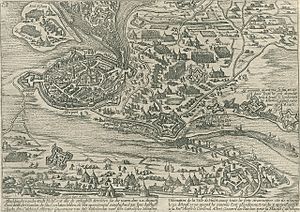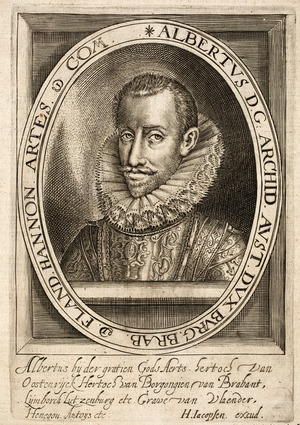Siege of Hulst (1596) facts for kids
Quick facts for kids Siege of Hulst (1596) |
|||||||
|---|---|---|---|---|---|---|---|
| Part of the Eighty Years' War & the Anglo–Spanish War | |||||||
 Engraving of the siege of Hulst of 1596 by Frans Hogenberg – collection Rijksmuseum Amsterdam |
|||||||
|
|||||||
| Belligerents | |||||||
| Commanders and leaders | |||||||
| Strength | |||||||
| Hulst: 3,700 Relief forces: 7,000 |
12,000 to 15,000 | ||||||
| Casualties and losses | |||||||
| 500 killed or wounded 3,000 surrendered |
1,300 to 2,000 dead 800 to 3,000 wounded |
||||||
The Siege of Hulst in 1596 was an important battle that happened from mid-July to August 18, 1596. It took place in the city of Hulst, which is now part of the Netherlands. This battle was part of two bigger wars: the Eighty Years' War and the Anglo-Spanish War. The Spanish army, led by Archduke Albert, won the siege. After a short fight, the Dutch and English soldiers defending Hulst gave up on August 18, 1596. Even though Maurice of Orange tried to help the city, his efforts failed.
Contents
Why the Siege Happened
Dutch Successes and Spanish Response
From 1590 to 1594, the Dutch army, led by Maurice of Orange, had many victories. They took control of many important towns and cities, including Hulst in 1591. In 1595, Maurice wanted to push the Spanish out of all cities north of the Rhine river. However, during the siege of Groenlo, a Spanish army arrived and forced Maurice to stop his attack.
The year 1596 started badly for the Dutch and English. The important French port of Calais fell to Spain. After this, Archduke Albert and his Spanish forces returned to Flanders. They planned a counter-attack. The people of Bruges even offered money for the Spanish to attack Ostend. But Ostend was too strong, with many new soldiers and supplies.
Archduke Albert's Clever Plan
Archduke Albert's army, with nearly 15,000 soldiers, marched from Antwerp. Their new commander was Sieur de Rosne. Albert wasn't sure whether to attack Bergen op Zoom or Breda. However, he had a clever trick up his sleeve. The Dutch were confused about where he would strike next.
Maurice's army was small, with only 5,000 soldiers. Many experienced English and Scottish soldiers were away fighting in Cadiz. The Dutch public helped by funding about 2,000 more soldiers. With Maurice's army spread thin, Albert realized he could attack Hulst without much trouble.
The Siege of Hulst Begins
Hulst's Defenses
Albert marched quickly towards Hulst, avoiding Maurice's army. Soon, his forces surrounded the city. Hulst was a small but strong town that controlled the Waasland area in Flanders. The Dutch and English had captured it in 1591.
The city's defenders had built several small forts, called sconces. They also used a system of sluices to flood the land around the city, making it harder to attack. The moat around Hulst had been made deeper. However, the city walls were only partly repaired.
The Battle for the City
Albert's clever plan had caused panic in Holland. But Maurice's army soon learned that Albert was heading for Hulst. Maurice quickly marched his troops towards the town. The Dutch hoped for a long siege. They had enough supplies for seven months. The city's commander, Count Georg Eberhard von Solms, was ordered to hold the city at all costs.
The soldiers inside Hulst fought bravely. They made several successful attacks outside the walls, called sallies. Despite this, Archduke Albert managed to capture the main dike and a strong fort called Moer. This allowed his soldiers to dig closer to the city walls.
The Spanish army suffered many losses. After only six weeks, nearly 600 of their soldiers were killed. Thousands more became sick or died from disease. The Spanish army commander, de Rosne, was also killed during a sally by the Hulst defenders.
The City Falls
The Spanish cannons fired fiercely at Hulst. They shot nearly 1,500 cannonballs, creating a large hole in the city wall. The defenders expected a direct attack. Instead, Albert told Count von Solms to surrender or face an immediate assault. The Count refused at first.
However, the Spanish then began digging a mine under the wall. This scared the soldiers and people inside the city. They had already lost about 700 people, mostly to disease. The fear of a massive attack that would destroy them caused panic.
Maurice and William Louis had approached Hulst to help. But Count von Solms, pressured by the citizens, had already asked to surrender. Maurice did try to relieve the city, but the Spanish defenses were too strong. He soon had to pull back. Even the Spanish were surprised that Hulst wanted to surrender so quickly. On August 18, 1596, Archduke Albert agreed to very good terms for the 3,000 soldiers defending the city.
After the Siege
Cost of Victory
For Archduke Albert, winning Hulst was very costly. About sixty officers and 5,000 soldiers died, mostly from disease. The city of Hulst was badly damaged. Nearly 3,500 cannonballs had been fired into and at the city.
The people of Zeeland were very unhappy with Count von Solms' actions. They removed him from command of their troops. However, this victory helped Archduke Albert gain the respect of King Philip II. It also ended a series of defeats the Spanish had faced in France and the Netherlands. Hulst would stay under Spanish control until November 4, 1645, when Prince of Orange captured it.
Dutch Recovery
After losing Hulst, the Dutch Republic worried that the Spanish would attack Axel and Biervliet. But Archduke Albert had lost too many soldiers. He did not have enough troops to continue his march and pulled back to Flanders. The Dutch learned this by intercepting a letter to King Philip.
The Dutch were relieved. Maurice now had an advantage because the English troops had returned from their success at Cadiz. He was able to launch a successful attack the next year. One of his first victories was defeating the Spanish at the Battle of Turnhout.
Images for kids
See also
 In Spanish: Asedio de Hulst (1596) para niños
In Spanish: Asedio de Hulst (1596) para niños




